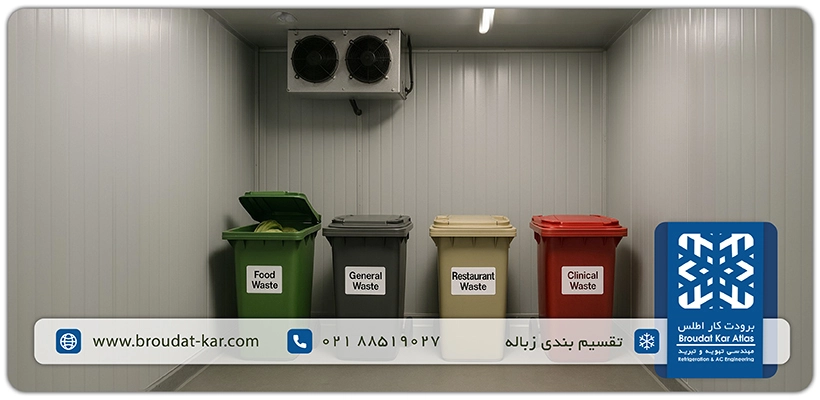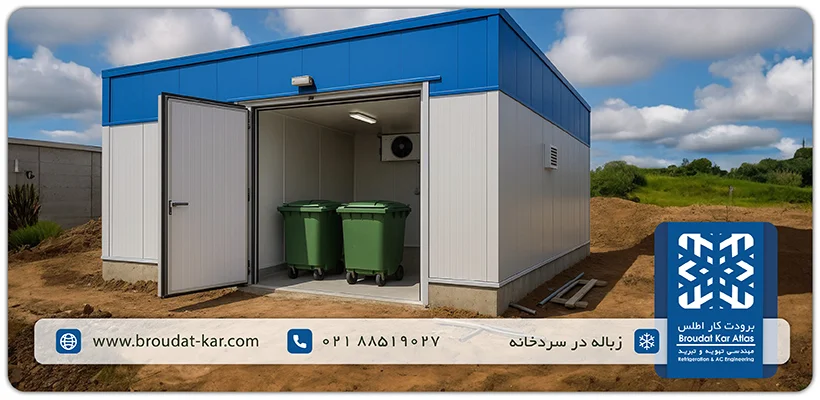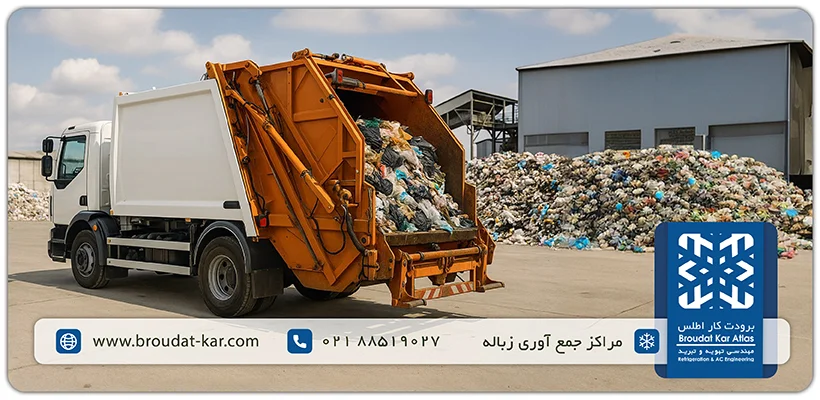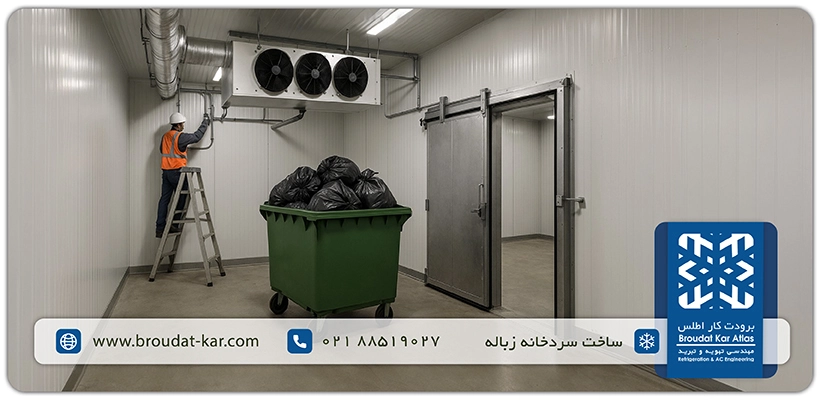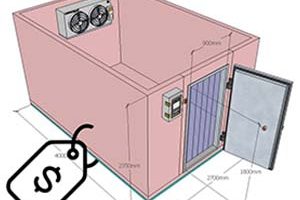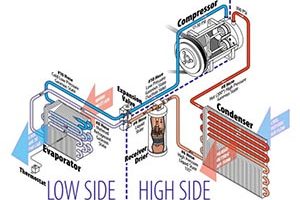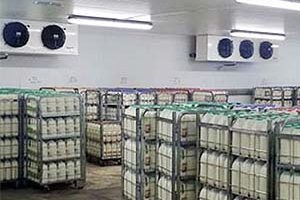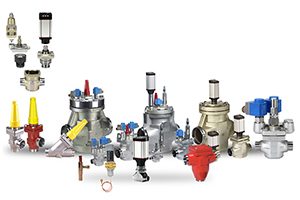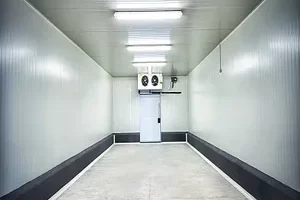What Is a Waste Cold Room?
One of the main challenges for urban management and industry is waste management. Today, with population growth and the increasing volume of waste—including waste from the food industry, healthcare facilities, and factories—new requirements have emerged for controlling and storing these materials. In Iran, given the high volume of municipal waste (more than 20,000 tons per day), the use of a waste cold room can significantly reduce environmental pollution.
A waste cold room—also called a waste cold room chamber—is an insulated space equipped with a refrigeration system that, by keeping the temperature low, prevents the rapid spoilage of waste and the release of foul odors. This space is used for the temporary storage of organic and inorganic waste until it is collected or transferred to processing or disposal units. When such a cold room is designed for infectious waste, it is referred to as a hospital waste cold room.
Purpose of Building a Waste Cold Room
A waste cold room goes beyond a simple warehouse; it is a system that pursues specific operational objectives. These objectives—odor control and the prevention of waste spoilage—are achieved by slowing the biological and chemical decomposition of waste. According to waste-management standards (such as the EPA’s guidance for hazardous-waste storage), these cold rooms make it possible to store waste from several hours up to several days.
| Notes | How It Works | Purpose of Construction |
| Odor reduction of up to 90% by slowing biochemical activity and fermentation—the primary sources of odor. | Temperature control / reduction of methane and hydrogen sulfide emissions | Reduce unpleasant odors |
| This is especially critical in hospital waste cold rooms. | Low temperatures slow the growth of bacteria, fungi, and insect larvae. | Prevent the growth of microorganisms |
| In the food industry and in hotels/restaurants, separating and keeping waste cold is part of Prerequisite Programs (PRPs) for hygiene. | Reduced leachate generation and mitigation of pest growth and secondary contamination. | Environmental sanitation |
| Enables better planning of collection frequency and lowers transport costs during periods of extreme heat. | _These systems ensure compliance with sanitary standards. | Logistics control |
Applications and Primary Locations
Waste cold storage is primarily used in situations where waste accumulation must be controlled in warm climates or high-volume environments. A summary of key applications is as follows:
Hotels, restaurants, and banquet halls
In kitchens or back-of-house areas, small-scale waste cold storage prevents the rapid spoilage of food waste, especially in warm environments. Surplus meals or organic waste are kept cool until collection.
Hospitals and healthcare settings
Medical waste—including biohazardous materials—and food waste from cafeterias are stored in refrigerated units to prevent contamination and comply with sanitary regulations. These units are often integrated into hospital basements or dedicated waste rooms.
Municipal and commercial waste-management facilities
Large-scale cold storage rooms at waste-processing plants, transfer stations, or landfills are used to temporarily hold waste before final disposal or recycling. This is common in urban areas with high waste generation, such as cities in China or Europe. The goal is to curb decomposition cycles and reduce airborne pollutants.
Marine and remote locations
On ships or isolated sites where waste collection is infrequent.
Agricultural or food-processing sites
To manage crop residues or processing by-products in order to prevent rapid fermentation.
Features and Standard Requirements
The cold room standard is determined based on its safety and efficiency. These requirements must be aligned with international standards such as NYCRR Part 360.
Cold Room Temperature
The required temperature in these cold rooms ranges from 0 to 5 °C, depending on the type of waste being stored.
| Storage Duration | Required temperature (°C) | Waste Type |
| Storage for 1–3 days | 0-5 | General organic waste |
| Daily emptying up to 48 hours | 0-2 | Odor-prone (malodorous) waste |
| Daily emptying | 0-5 | Non-infectious hospital waste |
Ventilation and Exhaust
Controlled ventilation to remove gases—and an exhaust system with a fan resistant to greasy vapors—are of particular importance in this area. Odor-reduction measures can include activated carbon filters or localized ozone treatment.
Floors and Walls
Due to contamination risks and the need for frequent cleaning of these cold rooms, the floors and walls must be washable with disinfectants and alkaline detergents. This requirement should be considered when specifying the materials for the doors and floor.
Safety Equipment
Temperature sensor, alarm, data logger, and emergency power.
In general, the design of a waste cold room must be based on waste-generation capacity, climatic conditions, and the type of waste. Selecting insulation thickness, compressor capacity, and the ventilation system in accordance with the target temperature are fundamental design principles that must be taken into account.
What are the benefits of building waste cold rooms?
A waste cold room is a tool for controlling odors, microbial load, and organizing the logistics of waste removal. If properly designed and operated, it improves environmental hygiene while containing operating costs during hot seasons.
Odor and pest control: A temperature of 0–5 °C noticeably slows fermentation and the formation of malodorous compounds, reducing the presence of insects/rodents.
Curbing the growth of microorganisms: Microbial load increases more slowly; the risk of secondary contamination is reduced.
Improved environmental hygiene: Better leachate management, drier and washable surfaces; fewer neighborhood complaints.
Compliance with sanitary requirements and audits: A key advantage for the food industry (PRP/HACCP) and healthcare facilities.
Smoother collection logistics: Enables reasonable spacing between collection rounds and optimization of transport routes.
Worker safety: A controlled environment with low odor and mechanical ventilation.
Enhanced brand image and customer experience: Especially for restaurants, hotels, and food retail.
Mobile/containerized options: Suitable for temporary projects or sites with building constraints.
Reaping the benefits is only possible when the maintenance program and cleaning protocols are carried out regularly. Ignoring care principles can create new sanitary challenges for the environment.
Key considerations
Alongside the strengths, a waste cold room has challenges that—if not addressed from the outset in design and operation—lead to extra costs or sanitary risk.
_ Initial capital investment (insulated panels, refrigeration equipment, ventilation, flooring)
Modular and scalable selection; use of pre-fabricated containers; prioritizing the highest-impact items (adequate insulation, airtight door); phased purchasing.
_ Noticeable energy consumption (especially in hot/humid climates and with frequent door openings)
Thicker insulation; PVC strip curtain; “door-open” alarm; inverter fans/compressors; optimized defrost; condenser heat-recovery for service-water preheating.
_ Need for regular maintenance (proper defrost, coil washing, filter replacement, door sealing)
Seasonal service contract; weekly checklist; design for easy access to coil/filter; runtime reminders for fans/compressor.
_ Power-outage risk (rapid rise in temperature and odor)
Backup power source (generator/battery); remote high-temperature alarm.
_ Leachate and wastewater management (blockage, odor backflow)
Floor slope toward drains; door heater in cold climates; local pre-treatment and a regular wash schedule.
_ Condensation and slippery floors (if humidity/airflow are not properly managed)
Anti-slip flooring; target RH of 60–80%; uniform airflow; inlet damper; localized drying after wash-down.
_ Cross-contamination in poor designs (shared path with food/pharmaceuticals)
Color-coded containers; separate ingress/egress routes (preferably two doors).
_ Noise and vibration from units (impact on nearby residential/office spaces)
Anti-vibration mounts; proper placement of the condensing unit; silencers in exhaust ducts and limiting hours of noisy activity.
_ Legal and procedural requirements for medical waste (permits, labeling, separate transport)
Design from the outset per local regulations; staff training; standard labeling; integration of the transport route to the disposal site.
_ Environmental impact of refrigerants in case of leakage (GWP)
Periodic leak-detection program; logging of refrigerant charge; professional servicing of lines and fittings.
A large share of the above can be controlled with “proper design + timely maintenance + data-driven monitoring.” If, at the pre-purchase stage, a precise capacity assessment and site layout are carried out, costs decrease noticeably.
Broudat Kar Atlas, as a specialist in the design and construction of various cold rooms, ice makers, freezing tunnels, ice banks, IQF systems, chillers, air-handling units, and other refrigeration systems, has consistently sought to implement the most engineered, up-to-date equipment and cooling solutions at the best prices.
Conclusion
Ultimately, waste cold storage is an innovative and efficient solution that plays a significant role in sustainable waste management. This technology not only reduces the health and environmental problems caused by the accumulation of organic waste, but—through odor control, suppression of microbial growth, and the reduction of greenhouse-gas emissions—it also makes a substantial contribution to public health and environmental protection. Given its wide range of applications in urban, commercial, medical, and household settings, investing in such systems can be an effective step toward smart waste management in modern societies.
Sized to the daily volume and the inbound/outbound route; ensure easy access for the collection vehicle, and locate it away from sensitive human areas.
Color-coded segregation, durable packaging, shorter storage time limits, negative air pressure, and stricter disinfection protocols.
Based on the daily/seasonal waste generation rate, collection frequency, density, and circulation space.
Related posts
Waste Cold Room
Cold Room Price Estimation – Year 2024 At Atlas Refrigeration, we recognize the pivotal role cold rooms play in diverse
Cold Storage Equipment Cold storage equipment encompasses a variety of machines and devices specifically designed to store perishable goods at
What is Industrial Cold store? An industrial cold store is a large-scale facility designed and constructed to preserve and
Valves and Control Devices in Ammonia and Freon Refrigeration Systems The variety of valves and control devices in refrigeration systems
Installation and Commissioning of Cold Rooms The meticulous installation and commissioning of a cold rooms facility in a principled
